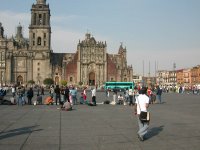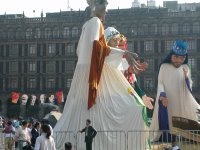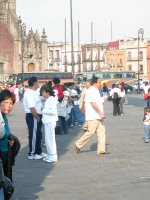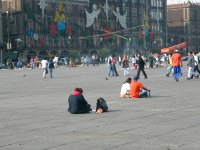
mostly undifferentiated space
Greetings from Mexico City. We arrived late Tuesday night, spent most of today walking around the historic center area. Our hostel is next to the Zocalo, the City's most famous public plaza, bordered by beautiful colonial buildings, including the Metropolitan Cathedral and National Palace.
 What do we ask of public places like this, at the heart of the City? For me, it´s mainly that it be open to everyone and to the broadest range of things people could be doing there. Today we saw folk healers, teenaged girls selling crafts accessories and dozens of other vendors, hip hop dancers, tourists; the Zapatistas and Socialists had tents up, and banners with pictures of Marx, Lenin, Stalin, and Castro flew near the most massive Nativity display I´ve ever scene, biblical characters looming at least 2-stories high.
What do we ask of public places like this, at the heart of the City? For me, it´s mainly that it be open to everyone and to the broadest range of things people could be doing there. Today we saw folk healers, teenaged girls selling crafts accessories and dozens of other vendors, hip hop dancers, tourists; the Zapatistas and Socialists had tents up, and banners with pictures of Marx, Lenin, Stalin, and Castro flew near the most massive Nativity display I´ve ever scene, biblical characters looming at least 2-stories high. There are no benches, trees, fountains, or paths in the Zocalo. (There used to be, according to displays in the subway tunnels that show black-and-white photos of the Zocalo carved up by all of the above.) There isn't much to define the space, other than a huge flagpole near the center and whatever the various groups there have set up themselves. (The flagpole shadow provides a thin line of shade, and people will line up in it.) In this mostly undifferentiated space, vendors and visitors sit anywhere, generally without orientation to any particular building or landmark or edge, about 15-20 feet away from anyone else so they have their own turf.
There are no benches, trees, fountains, or paths in the Zocalo. (There used to be, according to displays in the subway tunnels that show black-and-white photos of the Zocalo carved up by all of the above.) There isn't much to define the space, other than a huge flagpole near the center and whatever the various groups there have set up themselves. (The flagpole shadow provides a thin line of shade, and people will line up in it.) In this mostly undifferentiated space, vendors and visitors sit anywhere, generally without orientation to any particular building or landmark or edge, about 15-20 feet away from anyone else so they have their own turf.
Echoing Richard Sennett's claim that people have withdrawn from public personas into private preoccupations with the self, there are designers who say Americans have forgotten how to use public space, in contrast to places such as Latin America, China, developing countries, etc. (One L.A. architect says: "Italians come out of the womb knowing how to use public space--Americans, we don't have it, we don't get it in the culture, we have to learn how to use public space because we are such a suburbanized, privatized culture...People who grew up in Mexico, who know how to use public space, they don't need lessons.")
Now, I've seen people in Beijing squat on the sidewalk at a busy intersections to eat lunch, and senior citizens in Shanghai going at brightly-colored exercise equipment in playgrounds. But the Italian/Mexican/Chinese womb theory seems shaky. Much simpler to say the Zocalo (and countless other minimalist plazas in Mexico City) thrives with almost no stuff in it not because it's Mexican but because there's a central subway stop there, huge tourist attraction/nationally significant buildings adjacent, and the weather is usually gorgeous--even public space amnesiacs would probably sit their ass down in a place like this.

0 Comments:
Post a Comment
<< Home